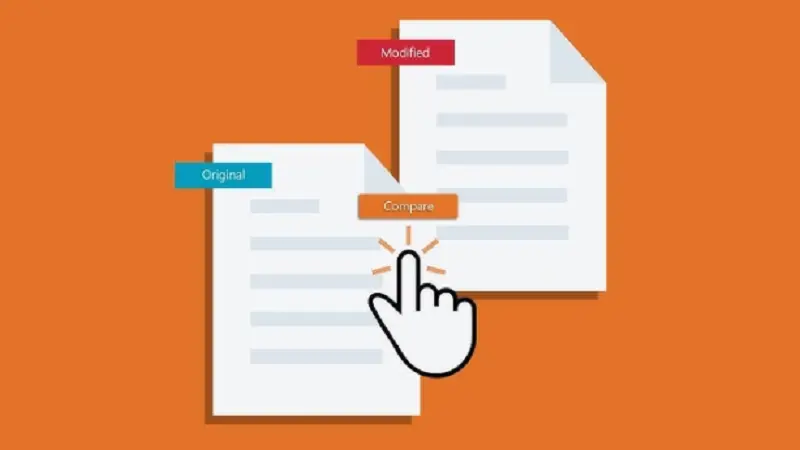Efficiently comparing updated iterations and draft revisions between two or more versions of the same originating document remains a vital organizational need for precisely tracking granular changes to content over time to meet review requirements.
This guide contrasts manual techniques versus automated document differencing tools regarding capabilities, security considerations, and usage procedures followed by best practices for optimal change management.
Manual Comparison Methods
Side-by-side Comparison
A rudimentary yet visual technique relies on printing out hard copies of documents under review and manually skimming them side-by-side on desk space for identifying changes, allowing users to physically markup observed alterations through pen annotations, highlights, and comments for basic change tracking. However, print costs and environmental impact build up rapidly.
Visual Inspection for Differences
Alternatively, reviewers can open copies of revised documents on-screen and digitally scroll between them to visually spot macro-level layout, formatting, paragraph, or text-level changes through human observation alone. However, this quickly proves fatiguing and ineffective for catching granular edits.
Highlighting Changes in Each Document
Reviewers may also manually highlight observed revisions in separate copies of a document using built-in editor tools to call out edits, allowing some change visualization. But lacking automation, this remains an extremely labor-intensive and error-prone approach.
Automated Comparison Tools
Software Options for Document Comparison
Top automated document differencing tools include native capabilities in Microsoft Word for comparing between file versions, alongside advanced specialty options like Workshare Compare for legal documents, DocsCorp compareDocs for contracts, and PopAI’s ai pdf reader that can discern granular changes between documents spanning content, formatting, and objects.
Features and Benefits of Using Automated Tools
Powered by efficient comparison algorithms, these tools can accurately identify minute differences between two document versions in seconds as a huge automation boost for change tracking. This minimizes the human effort needed for reliably flagging updates for reviewer consideration.
Step-by-Step Process for Using Automated Tools
The general workflow for leveraging automation involves importing the original and revised document versions into the selected diff software tool to feed the comparison engine. Next, tools run comparisons before showcasing all differences in an intuitive, highlighted user interface. Finally, detailed change reports can be generated and exported for downstream usages like archival or notifications.
Considerations for Document Comparison
Accuracy and Reliability of Comparison Results
Poorly or inconsistently formatted documents with irregular indents, missing typeface markings or other structural issues can markedly decrease the accuracy of automated tools. But generally, most achieve over 90-95% precision on cleanly structured documents, allowing supplementary manual verification.
File Formats Compatibility
Specialized legal document comparison tools cater to correctly parsing niche file types like CAD diagrams alongside legal templates, while more generalized offerings primarily focus on maximizing Word DOC and DOCX format compatibility, common PDF files, along with Excel and other prevalent Office file types.
Security and Privacy Concerns
When assessing automated document differencing systems, particularly web-based or cloud-hosted solutions, reviewers must thoroughly evaluate implemented data privacy protocols to ensure sensitive documents remain adequately protected when uploading to external third-party systems, while meeting confidentiality commitments.
Best Practices for Document Comparison
Establishing a Clear Comparison Methodology
Institutions benefit greatly from defining and socializing standardized procedures, preferred tool selections, and availability considerations specifically optimized for document change comparison needs based on assessing factors like accuracy requirements, supported formats, automation demands and processing volumes.
Regularly Updating Documents for Accurate Comparison
To enable reliable differencing visibility, document owners should routinely refresh retained copies of materials under appropriate configuration control to the latest active versions before kicking off the review to correctly baseline changes against currently approved editions only.
Proper Documentation of Changes for Future Reference
By comprehensively exporting and archiving detailed change reports generated from compared document versions under standard naming conventions into records management systems, organizations can retain lasting indices of modifications applied over time for reference during audits.
Conclusion
In closing, a balanced approach combining manual comparison techniques like visual side-by-side skimming and comments with targeted deployment of automated document differencing tools yields strong ROI for organizations through boosted efficiency, accuracy, and visibility when tracking updates between versions. Following cybersecurity best practices while proactively standardizing methodologies centralized around supported file types vastly improves reviewing efficiency in pinpointing even minute content changes across versions for streamlining governance.
